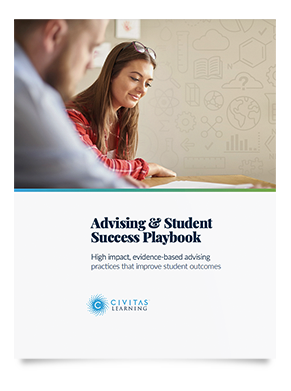
4 Challenges Derailing Academic Advisor Effectiveness (And How to Fix Them)
Share this Post
Effective academic advising teams have the power to significantly impact student success, but often there are unseen barriers preventing advisors from reaching the right students at the right time. Each year advising is one of the most impactful initiatives for improving persistence in the Civitas Learning Student Impact Report.
However, this study also found that, while advising can work, 47% of advising programs aren’t improving student outcomes. It’s clear that it’s possible to improve student outcomes with effective advising programs, but how do you ensure that your investment in advising pays off?
Despite hard work and good intentions, four common challenges limit advisors’ impact, including:
- Unmanageable Advising Caseloads
- Poor Visibility into Student Need Throughout the Term
- Lack of Alignment Across Departments
- Low Student Engagement
Let’s explore why these challenges persist in advising programs and the steps you can take to empower your advising team to do their highest and best work to support student success.
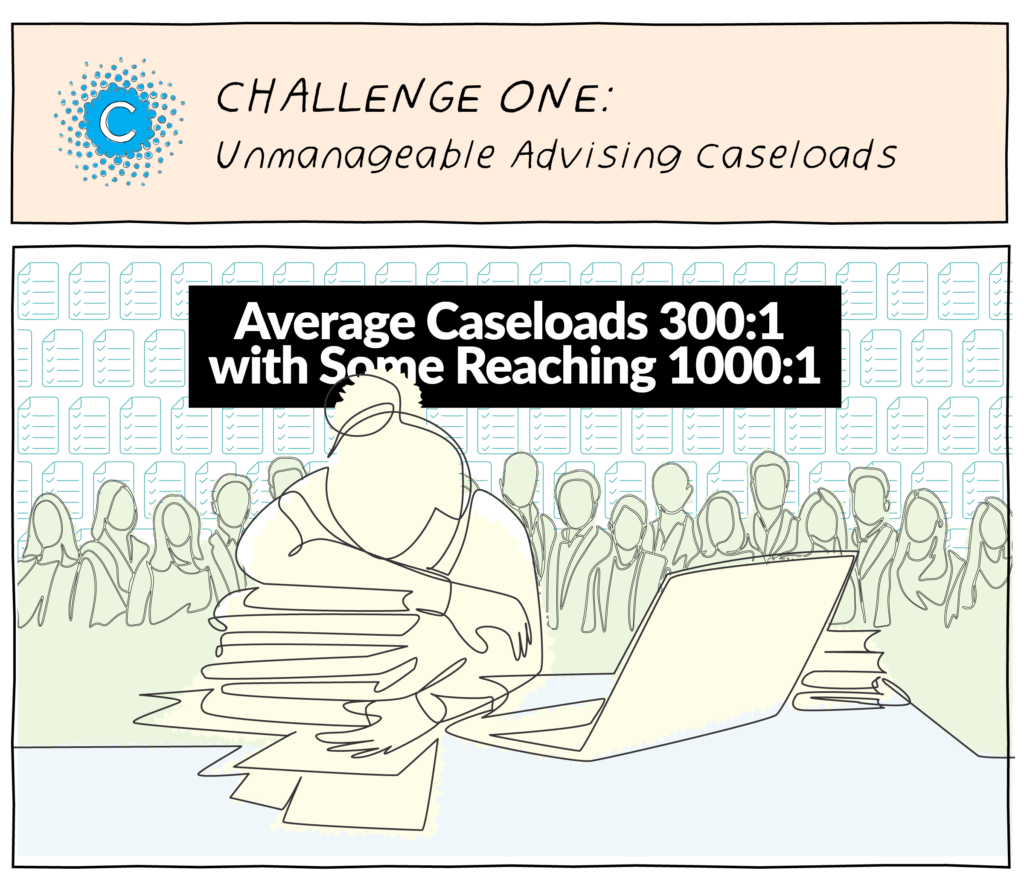
Challenge One: Unmanageable Advising Caseloads
The average advisor’s caseload is approximately 300 students per advisor. But this familiar statistic doesn’t tell the whole story. Many institutions report caseloads that significantly exceed this average, with some reaching as high as 1000 students per advisor.
A recent Tyton Partners survey found the higher the advising caseload, the shorter the meetings with students. Advisors experiencing the very highest caseloads often only have 10 minutes to meet with each student. Barely enough time to assist with course registration, let alone provide holistic support.
Not having enough time to have meaningful engagement with students limits success and quickly leads to burnout and turnover among advising teams. Staff attrition only exacerbates this situation. Several Civitas Learning partner institutions share that losing just 1 or 2 advising staff strains the remaining advising team’s already limited capacity and emotional bandwidth.
Many advisors and student success professionals feel overwhelmed, overworked, underpaid, and underappreciated by their institutions. Eighty-four percent of student affairs professionals say stress and crisis management lead to burnout. Four out of 10 share they plan to leave higher education in the next five years. And almost half say they wouldn’t recommend entering the profession.
Solution: Empower Advisors with Intelligent Case Management Tools
Hiring more advisors to manage excessive caseloads seems the obvious solution, but it often isn’t feasible. Another way to ease capacity constraints is to use intelligent workflows and integrated case management tools to reduce administrative burden. A data-activated workflow tool empowers advisors to shift from transactional advising to transformative advising at scale.
Without intelligent case management tools, it can be challenging for advisors to manage all the day-to-day actions it takes to support hundreds of students. Access to integrated calendaring, built-in appointment scheduling, shared notes and alerts, and auto-updated student lists streamline daily work leaving more room to help students – and can make it easier to quickly onboard new advisors.
Equipping advisors with intelligent workflow and integrated case management tools can make a caseload of 500 students feel more like 200. This way of organizing means advisors can spend less time on administrative work and more time delivering proactive support throughout the term.
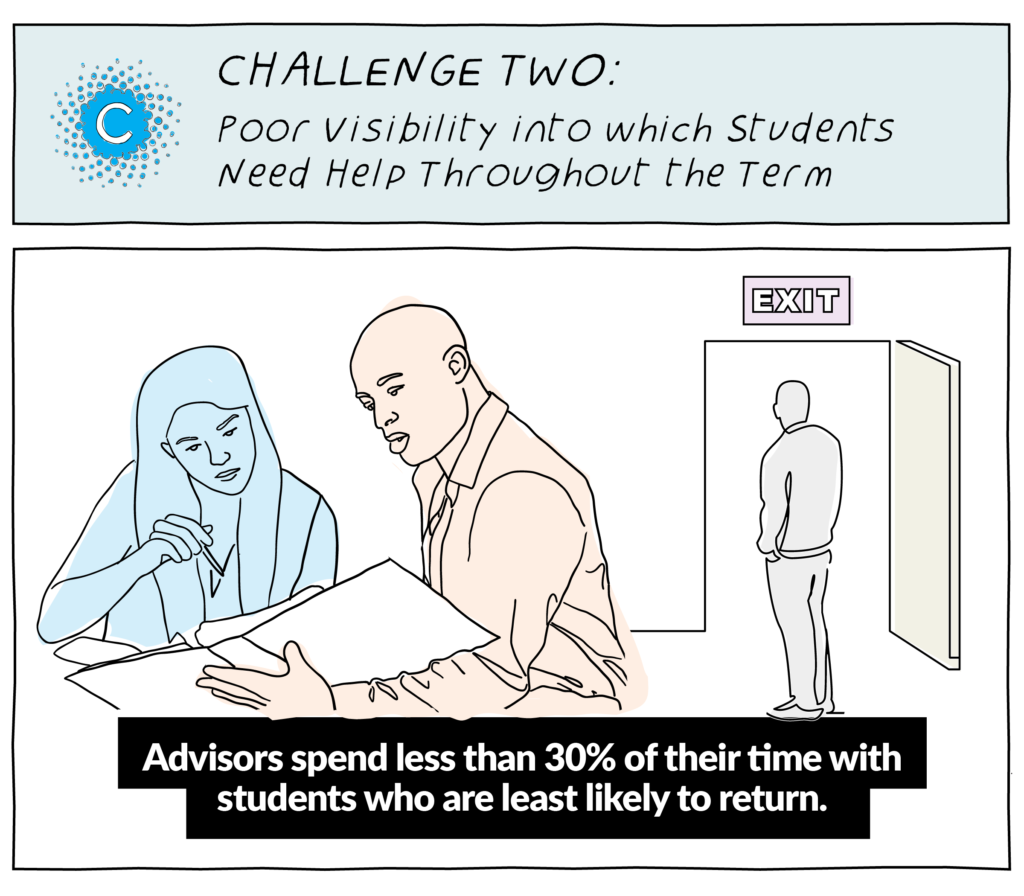
Challenge Two: Poor Visibility into which Students Need Help Throughout the Term
Students’ needs and circumstances are always changing. A recent analysis of Civitas Learning partner institutions revealed that, on average, 39% of students’ likelihood to persist toward graduation changes within a term. To make a difference before it’s too late, advisors need access to data as dynamic as their students’ lives.
Effective academic advising programs depend on advisors connecting with students at the right time with the right information. Internal analysis of Civitas Learning partner institutions found that without visibility into which students are in need, advisors typically engage strategically with only 25% of highly vulnerable students within a term.
Instead, advisors use most of their time helping students who are often better prepared for college and usually in less need of personalized help. Those most likely to persist typically seek services on their own – keeping advisors’ calendars full, especially around peak advising times, limiting the capacity to serve the most vulnerable students.
Access to comprehensive data is essential to serving students who need it most. Still, only 21% of institutions report that advisors have access to the information they need to monitor student risk. At best, advisors are limited to less effective generalized approaches or reactive interventions when this is the case. At worst, the limited view advisors get from disconnected systems, or static spreadsheets means vulnerable students fail to reach their academic goals.
Solution: Use Actionable Analytics to Identify Who Needs Help & How to Help Them
Access to actionable analytics enables advisors to move beyond one-size-fits-all services driven by the registration cycle. Instead, real-time insight into important student data points like persistence and completion predictions allows advisors to organize their outreach efforts based on need rather than demand.
For instance, the ability to monitor shifts in a student’s likelihood to persist is often one of the earliest indicators of risk an advisor can check in on. Actionable insights, like persistence prediction, do more than help advisors identify potential risks. They reveal proactive student engagement opportunities, help prescribe specific actions, and give unique direction to each student.
Instead of relying on historical data for lagging insights, actionable analytics that include behavioral and engagement data provide just-in-time information that can guide advisor case management. Making it easier for advisors to proactively engage and support at-risk students helps institutions scale proactive, personalized support to improve student outcomes.
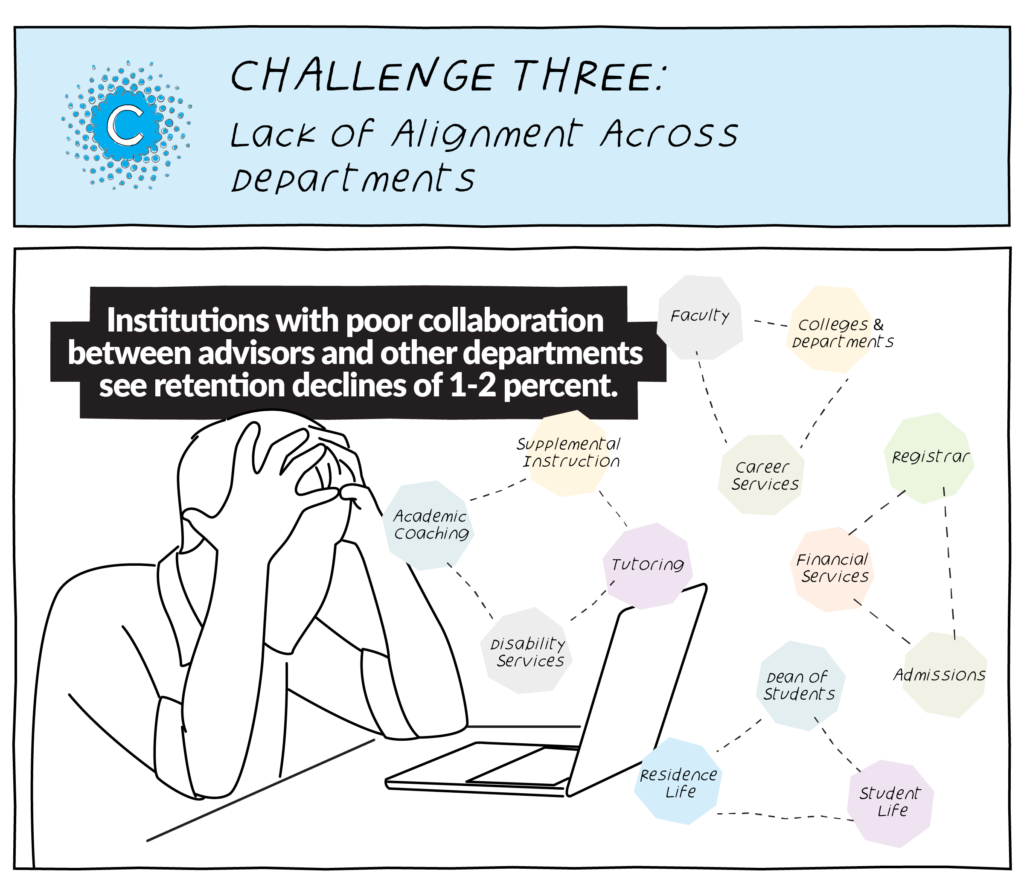
Challenge Three: Lack of Alignment Across Departments
Student success should be a shared responsibility, but a recent survey of higher education leaders and practitioners identified a lack of coordination across departments as the third most significant barrier to student success (after budget and advising caseloads).
A coordinated effort to support students isn’t nice to have. It’s a must. But barriers to cross-functional collaboration like unclear accountability, lack of goal alignment, and information silos stand in the way of coordinated student support -resulting in a fragmented student experience and less effective student services.
The most collaborative institutions increased retention rates by 1-2%, while the least cooperative institutions experienced declines in similar proportions. Unifying disconnected student support can be challenging without a shared source of truth. When everyone works toward different goals using different information, lines of responsibility become unclear, work is duplicated, and communication with students is confusing.
Solution: Build a Coordinated Student Success Coalition
Advising is powerful, but it becomes even more impactful when everyone on campus is involved. Isolated efforts or interventions that depend on advisors alone can’t consistently deliver improved student outcomes. Consistent, sustainable student success depends on multi-faceted, data-activated student success coalitions that bridge efforts across student and academic affairs.
In addition to coordinated efforts, advisors and other support professionals need a single source of knowledge that provides a full picture of a student’s experience. A holistic record of all communication (emails, referrals, SMS, messages, announcements, surveys, and notes) executed within a student’s profile provides the visibility and context needed to maintain a cohesive frontline of student support. With shared context and unified goals, everyone on campus can collaborate to provide seamless support that drives student outcomes and eases inefficiencies.
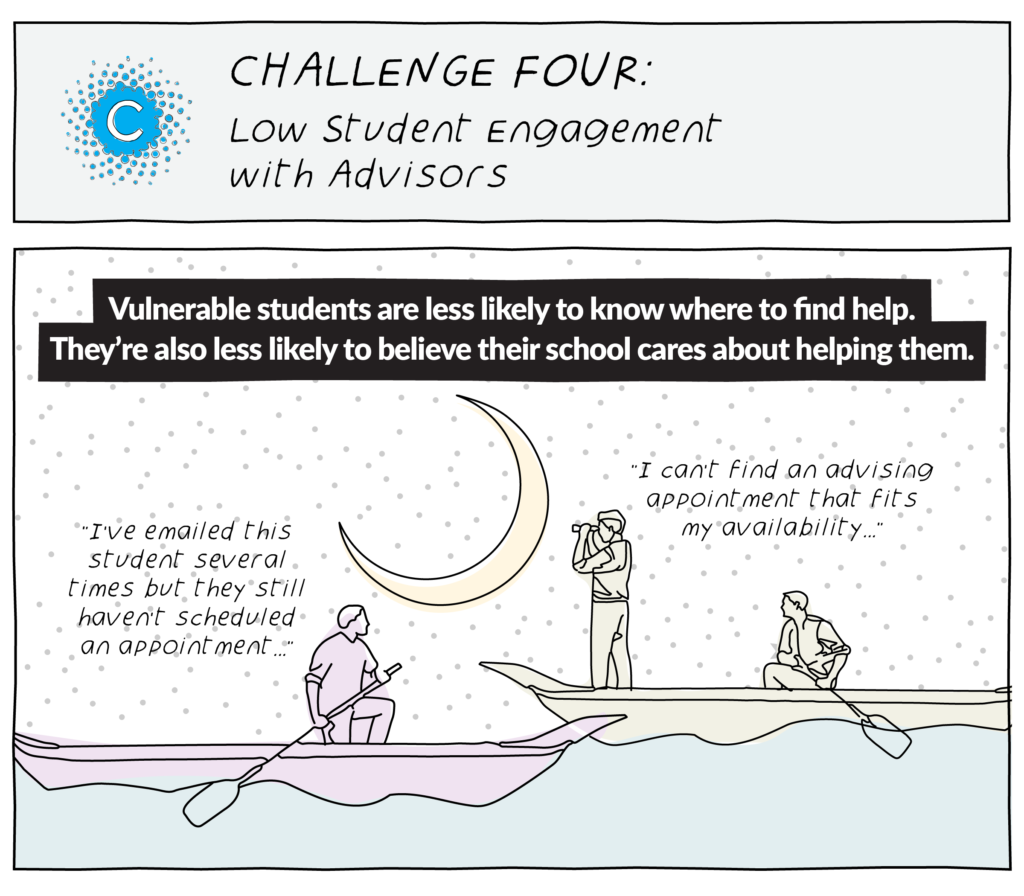
Challenge Four: Low Student Engagement with Advisors
Despite best intentions, getting students to seek help from an advisor before it’s too late can be tricky. If those who need help don’t respond to advisor outreach, it becomes nearly impossible to support them.
Many students simply don’t know or trust that support is available to help them along their journey. A recent survey found that at-risk students were less likely to:
- Receive support in the past
- Know where to find help
- Believe that their school cares about helping them
Vulnerable students are uncertain about where to find support and guidance, and this discomfort is amplified when institutional systems and procedures are difficult to navigate. Students balance many extracurricular obligations alongside completing their education. Plus, busy schedules and competing commitments can make finding a time to meet with an advisor difficult.
The good news? Despite uncertainty about accessing help, at-risk students are open to the idea of getting support. In the same survey, 79% of at-risk students said their institution might be able to help get them back on track. However, when asked how institutions can improve support services, students’ responses differed across student groups -which emphasizes the importance of a personalized approach to addressing student needs.
Solution: Build Trust and Make It Easy to Access Help
To overcome students’ hesitation about asking for help, advisors need a sixth sense to proactively identify and reach out to students who need support. Communicating in ways that resonate with students at critical moments helps them feel seen and supported by their advisors. To make accessing help easy, advisors must offer a variety of appointment modalities to meet the preferences of their students. With intelligent case management capabilities, advisors can help students follow through on scheduled meetings with built-in notifications and reminder functionality to help nudge busy students to attend important meetings.
In combination with analytics, intelligent case management capabilities enable advisors to tailor support to differing student needs. For instance, advisors can reach out to students who are likely to persist by using one-to-many advising modalities like group advising or general nudges. In contrast, students with a lower likelihood to persist might benefit from more personalized interventions like one-to-one appointments and direct phone calls. By connecting with students in ways that resonate with them, advisors can improve the effectiveness of their outreach efforts, ultimately making a more significant impact.
It’s Possible to Overcome These Challenges
These common barriers to advising effectiveness may be standing in the way of significant gains in student success, but it’s possible to overcome them. Institutions can address these challenges and offer proactive, holistic support to their students with the help of data-informed workflow tools and intelligent case management in one unified platform.
With access to actionable analytics and predictive insights, coupled with streamlined workflow tools, advising teams have the capacity and visibility to effectively support all students along their academic journey.
